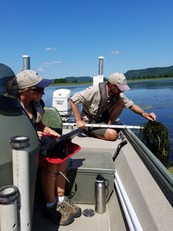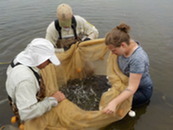|
Volume 12- September 2023
Aquatic Ecosystems
Our lakes and rivers are alive, from the complex communities of microscopic zooplankton, to diverse stands of undulating underwater vegetation, to the snapping jaws of fish and turtles. The mysteries of how these creatures depend on and support each other, not to mention the multitude of life flying above or lapping at their shores, continue to surprise observers. This issue of the Reader highlights trends in Upper Mississippi River vegetation, surprises about the influence of aquatic invasive species on water clarity and fish production, and an examination of sport fish diets in lake communities.
For more information about research on aquatic ecosystems in Minnesota, you can visit the long-term monitoring websites for plants and animals, lakes, and rivers. Many partnerships work together to better understand aquatic ecosystems in our state, including the Minnesota Aquatic Invasive Species Research Center, Science Museum of Minnesota, and the Large Lakes Observatory, to name a few.
---
The Minnesota Research Reader is a collaboration between the Minnesota Department of Natural Resources and the U.S. Department of Agriculture Forest Service that provides a quick look at emerging research relevant to our work in the State of Minnesota. We hope you enjoy the selection of articles in this month's edition of the Reader!

This 2022 article was coauthored by Eric Lund, a plant ecologist with the Minnesota Department of Natural Resources. Restoring habitat in the Upper Mississippi River requires long term monitoring to set goals and understand progress toward reaching them. Standard time-efficient, rake-based monitoring techniques yield only an index of abundance, however, with limited application for wildlife managers. This research team identified a relationship between standard boat-based rake abundance indices and more intensive diver-based biomass measurements. The relationship enabled researchers to back-estimate submerged plant biomass in the historical long term monitoring dataset (1998-2018) and will be used in the future to estimate biomass from standard data collection techniques.
Management Implications:
- Understanding submerged vegetation abundance is vital for knowing how it contributes to sediment stabilization, regulation of water clarity, important in-river biogeochemical processes, as well as food and habitat resources for multiple trophic levels.
- The quantification of submerged aquatic vegetation can be compared to other biotic data to better understand ecosystem relationships and inform overall ecosystem management.
- These data provide context for goal setting and monitoring for restoration projects focused on submerged aquatic vegetation.
|

Heidi Rantala, fisheries research scientist at the Minnesota Department of Natural Resources, led this study published in 2023. Despite the time period being marked by the establishment of zebra mussels and spiny water fleas, two aquatic invasive species known for influencing plankton communities, Lake Mille Lacs water clarity did not trend significantly clearer from 2000-2018. The authors conclude the water clarity effects of the two species cancelled one another out, resulting in a shift in lake production, which in turn had a zero-sum effect on water clarity.
Management Implications:
- The effects of invasive species may be unpredictable, especially when multiple species invade a system.
- Although no change in water clarity was observed, lake processes and energy flow likely did change, as evidenced by shifts in the zooplankton community and the large amount of zebra mussel biomass in the lake.
- Having multiple measures of ecosystem healthy, beyond just water clarity, are helpful for understanding how lakes respond to stressors like invasive species.
|

Kamden Glade led this 2023 collaborative study with researchers from the Minnesota Department of Natural Resources and Bemidji State University. The research examined how diets of sport fish, including largemouth bass, northern pike, and walleye, vary across ten Minnesota lakes, some with and some without muskellunge. They found that, within species, the fish diets were consistent regardless of the presence of muskellunge, and that diets were overall consistent across seasons. The prey consumed did vary among the different sizes of the predators. For example, small to medium northern pike diets were mostly composed of yellow perch, although black crappie were a greater proportion of the diet for larger northern pike. Finally, walleye and northern pike diets were most similar compared to all the species pairs in the study and muskellunge and largemouth bass diets were most dissimilar.
Management Implications:
- Muskellunge, northern pike, walleye, and largemouth bass can coexist in lakes as long as adequate prey is available.
- Largemouth bass appear to occupy a unique niche in these lakes, consuming more invertebrates than fish.
- Muskellunge had the most diverse diets of all the fish studied, resulting in low diet overlap with the other three species.
- Lake size, depth and productivity strongly influence these sport fish diets and can be used to infer feeding habits when diet data are not available.
|

This collaborative research, published in 2023, brought together biologists from the Minnesota Department of Natural Resources, University of Minnesota Duluth Natural Resources Research Institute, Voyageurs National Park, and University of Minnesota to describe resource use of popular sportfish in nine of Minnesota's largest lakes. At the time of sampling, the lakes were at different stages of invasion by spiny water flea and zebra mussels, yet results indicated adult and age-0 walleye and yellow perch had remarkably similar resource use across all lakes. Carbon and nitrogen stable isotope signatures from tissues of fish, macroinvertebrates and zooplankton were used to determine where walleye and yellow perch consumed most of their prey, either in the offshore pelagic zone supported by zooplankton or the nearshore littoral zone supported by macroinvertebrates. Regardless of invasion status by spiny water flea and/or zebra mussels, both walleye and yellow perch, at both life stages, were primarily supported by production from the pelagic zone of lakes rather than the littoral zone of lakes.
Management Implications:
- The results of this study differ from others that documented walleye and yellow perch shifting to near-shore prey bases after zebra mussel invasion, possibly due to the large surface area of these study lakes.
- Reductions in walleye and perch growth following the introduction of spiny water flea and/or zebra mussels might be due to those fish continuing to rely on resources that become less abundant.
- Resource use of walleye and yellow perch was fairly consistent across the lakes, indicating similar strategies for increasing or maintaining production may be useful across all nine systems.
|
|